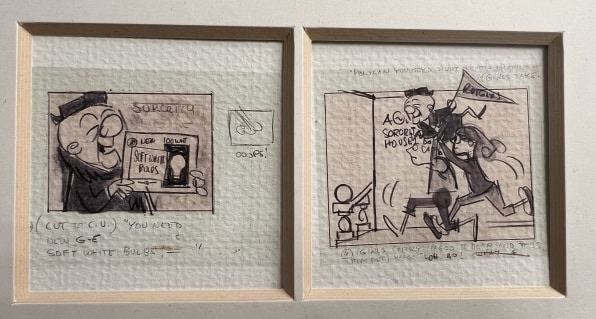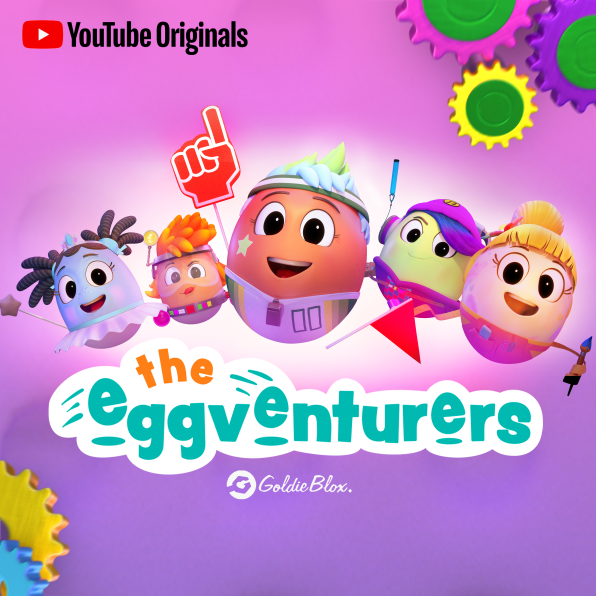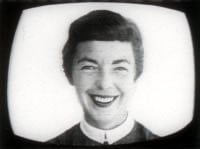For GoldieBlox’s Debbie Sterling, animation is a family business
When Debbie Sterling was growing up, she knew that her grandmother, Sterling Sturtevant, had been a designer in the animation business in the 1950s and early 1960s–working on Mr. Magoo cartoons, inventive TV commercials, and more–back when few women had creative jobs in the industry. Tragically, Sturtevant died of pancreatic cancer in 1962 at age 39, long before Sterling was born. But she was very much a presence in the household.
“As a kid, she was a legend in my eyes,” Sterling explains. “How cool was it to have somebody who worked on animation [in the family]? We had pictures of some of her art around the house, and we all kind of idolized her and her work. And in particular, she was really a role model for me because I was fortunate enough to have artistic ability that I believe was passed down from her.”

Instead of pursuing an art career, Sterling ended up getting a degree in mechanical engineering from Stanford. Bothered by the underrepresentation of women in technical fields, she started to think of ways to get girls more interested in STEM careers. And that led her to create GoldieBlox–a Kickstarter campaign that became a full-blown company focused on toys meant to get girls building stuff.
Along the way, the GoldieBlox brand expanded from playthings into content. “Even in the earliest days as a toy company, we were actually producing a lot of media, because we were doing our own marketing in-house,” says Sterling. “And a lot of the videos that we made in our early days went viral and really put the company on the map.”
Eventually, GoldieBlox produced several shows available on YouTube—a little animation, but mostly live-action series that furthered its mission of empowering girls. So when Sterling learned that YouTube had created a $100 million fund to invest in kids’ programming that encouraged character traits such as compassion, teamwork, and creativity, it was only natural that she sought to get some of that money for GoldieBlox.
Her company prepared a bunch of pitches inspired by the videos it had been making over the past five years. At the last moment, as “a wild card,” Sterling threw in an idea loosely inspired by “This is Your Brain on Engineering,” a 2014 video GoldieBlox had produced to promote its products and mission. The video featured a live-action egg wearing a tiny wig, riding through a Rube Goldberg-like contraption made from GoldieBlox toys. It became a viral hit–racking up 76 million page views to date—but did so at such a leisurely pace that it took years for Sterling to notice.
Her new pitch, The Eggventurers, was a computer-animated show starring a whole gang of adventuring, anthropomorphic eggs. And you’ve probably figured out by now that YouTube loved it. It became a 13-episode YouTube Originals series produced in partnership with Canadian animation studio Mainframe.

Most of the protagonists of previous GoldieBlox videos have been girls—human ones, that is. A show starring a friendly bunch of eggs is certainly a departure. But according to Sterling, eggs are surprisingly relatable. They’re “just so universal,” she says. “Everyone around the world knows and recognizes an egg.”
Eggs as heroes helped make Eggventures—which Sterling says is “very gender neutral”—more accessible to a broad audience. So did keeping the quantity of dialog to a minimum rather than getting too talky.
The first episode of The Eggventurers, “Zombie Eggpocalypse,” premiered last week on YouTube, where it’s been viewed 1.8 million times so far. Sterling is the creator and executive producer. After years of channeling her artistic bent mostly into doodling, she’s achieved a lifelong dream inspired by her grandmother’s career in animation.
Rediscovering a pioneer
Now let’s talk more about Sterling Sturtevant, just because she and her work as a cartoon designer are worth celebrating. Back when Sturtevant aspired to enter the animation field, its disinterest in providing opportunities to women was downright official: “Women do not do any of the creative work in connection with preparing the cartoons for the screen, as that task is performed entirely by young men,” a Walt Disney Productions administrator helpfully explained to a female would-be trainee in a 1938 form letter. “For this reason, girls are not considered for the training school.”
In truth, that policy wasn’t quite absolute. For instance, an animator named Retta Scott worked on Bambi. Bianca Majolie and Sylvia Moberly-Holland were Disney storyboard artists in the 1930s; in the 1940s, Mary Blair was an innovative color stylist. And after Sturtevant graduated from the Chouinard Art Institute in Los Angeles, her talent won her a job at the Disney studio, where she got her first screen credit for the story of Bone Bandit, a 1948 cartoon starring Pluto.

But Sturtevant really started to make her mark when she was hired by UPA, the relatively new studio famous for its modern, design-centric approach to animation. Among other contributions to its cartoons, she redesigned Mr. Magoo—initially a jowly, downright intimidating character—into the more endearing fellow we now recognize. Here’s When Magoo Flew, an Oscar-winning cartoon she designed.
After leaving UPA, Sturtevant went to a small studio called Playhouse Pictures, which employed some of the industry’s top talent and specialized in the production of commercials—pretty clever ones that remain entertaining and stylish today.
At Playhouse, Sturtevant also designed some of the very first animation to feature Charles Schulz’s Peanuts kids, who starred in Ford commercials (and bits for The Tennessee Ernie Ford Show) years before the production of A Charlie Brown Christmas, their first holiday special. As recounted in Amid Amidi’s book Cartoon Modern, Schulz was a fan of her interpretation of his characters, saying that one commercial would benefit from “Sterling’s touch.”
Where Sturtevant might have taken her career if her untimely passing hadn’t cut it short, we’ll never know. The good news is that a lot of the animation she designed is available on YouTube—which is not only a platform for new creations such as The Eggventurers but also an endless trove of decades-old media that might otherwise remain nearly impossible to watch. Sixty years after Sturtevant’s death, animation fans and scholars are rediscovering her “immaculate design.”
You can imagine what that means to Debbie Sterling. “As a woman who always worked and studied in male dominated fields, to see someone like my grandmother start to get some recognition, it’s a really powerful thing,” she says. In a Medium post, Amy Sterling Casil—Sterling Sturtevant’s daughter and Debbie Sterling’s aunt—wrote that Sturtevant’s posthumous fame is bittersweet. But it’s still nice to see a pioneer get her due–even if it took far too long.
(16)


